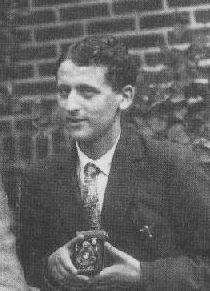
Benjamin Smith Barton was an American botanist, naturalist, and physician. He was one of the first professors of natural history in the United States and built the largest collection of botanical specimens in the country. He wrote the first American textbook on botany.

Lewis Boss was an American astronomer. He served as the director of the Dudley Observatory in Schenectady, New York.

Samuel Abraham Goudsmit was a Dutch-American physicist famous for jointly proposing the concept of electron spin with George Eugene Uhlenbeck in 1925.

Benjamin Alvord was an American soldier, mathematician, and botanist.

William Henry Brewer was an American botanist. He worked on the first California Geological Survey and was the first Chair of Agriculture at Yale University's Sheffield Scientific School.

John Merle Coulter, Ph. D. was an American botanist and educator. In his career in education administration, Coulter is notable for serving as the president of Indiana University and Lake Forest College and the head of the Department of Botany at the University of Chicago.

Merritt Lyndon Fernald was an American botanist. He was a respected scholar of the taxonomy and phytogeography of the vascular plant flora of temperate eastern North America. During his career, Fernald published more than 850 scientific papers and wrote and edited the seventh and eighth editions of Gray's Manual of Botany. Fernald coauthored the book Edible Wild Plants of Eastern North America in 1919–1920 with Alfred Kinsey, which was published in 1943.

Elmer Drew Merrill was an American botanist and taxonomist. He spent more than twenty years in the Philippines where he became a recognized authority on the flora of the Asia-Pacific region. Through the course of his career he authored nearly 500 publications, described approximately 3,000 new plant species, and amassed over one million herbarium specimens. In addition to his scientific work he was an accomplished administrator, college dean, university professor and editor of scientific journals.
The Bryologist is a peer reviewed scientific journal specializing in bryology. It is published quarterly by the American Bryological and Lichenological Society (ABLS). It began as a department of The Fern Bulletin devoted to the study of North American mosses. Its first editor was Dr. Abel Joel Grout, who intended the bulletin to be "enabling any one at all interested in mosses to get some knowledge of these plants without excessive labor or expense ... the editor will also try to identify for subscribers difficult specimens accompanied by notes and return postage."

Symphyotrichum lateriflorum is a species of flowering plant in the aster family (Asteraceae). Commonly known as calico aster, starved aster, and white woodland aster, it is native to eastern and central North America. It is a perennial and herbaceous plant that may reach heights up to 120 centimeters and widths up to 30 centimeters.

Benjamin Lincoln Robinson was an American botanist.
Polygonum fowleri, commonly called Fowler's knotweed or Hudsonian knotweed, is a plant species native to the seashores of the northern part of North America. It has been reported from every Canadian province and territory except Alberta and Saskatchewan, as well as from Maine, Alaska, Washington, Oregon, California, and St. Pierre & Miquelon. It is usually found in gravelly locations along the seacoast.
Rorippa microtitis, the Chihuahuan yellowcress, is a plant species native to Chihuahua, Arizona and New Mexico. It is widespread in Arizona but has been recorded from only one county in New Mexico (Catron).
Albion Reed Hodgdon was an American botanist, plant taxonomist, herbarium curator, and leading authority on the flora of New England.
Norton George Miller (1942–2011) was an American bryologist and paleobotanist. He was the president of the American Bryological and Lichenological Society from 1985 to 1987.

Anna Buck Nickels was an American cactus collector and florist. She was for many years one of the most important collectors, cultivators, and popularizers of the cactus of Mexico and southern Texas. The standard author abbreviation A.B.Nickels is used to indicate this person as the author when citing a botanical name.
Pauline Lesley Perry is a South African botanist, horticulturalist and plant collector.

Emma Jane Cole was an American teacher, botanist, and curator, and the author of Grand Rapids Flora: A Catalogue of the Flowering Plants and Ferns Growing Without Cultivation in the Vicinity of Grand Rapids, Michigan. She was inducted into the Michigan Women's Hall of Fame in 2007.
Lincoln Ware Riddle was an American botanist who specialized in the study of lichens. Born and educated in Massachusetts, Riddle made significant contributions to lichenology, leveraging extensive scientific collections at Wellesley College and Harvard University. Throughout his career, he held esteemed positions at both institutions and was actively involved in botanical societies and editorial boards. His untimely death at the age of 40 left a notable void in the botanical community, but his impact remains, marked by various publications and honors.

Jane Loring Gray (1821–1909) was an American editor. Although she was not herself a botanist, through her sympathy with her husband, Asa Gray, in his scientific work, she became acquainted with most of the American botanists of his time and, as his companion during his travels in Europe, she met many distinguished foreign botanists of that generation as well as some of the botanists of a still earlier generation.












